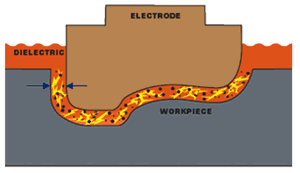Eliminating Benchwork For Large Mold Surfaces
EDM dielectric additives can subtract labor costs for mold makers by eliminating the need for secondary hand polishing.
Share




The real rub in moldmaking is the secondary hand polishing often required to massage a machined mold surface to the mirror-like finish necessary for the molding process. This extra step is particularly time-consuming for large molds that have a significant surface area to be polished. Every mold maker strives to eliminate such benchwork to compress total tool manufacturing time and speed turnaround to its customers.
Ram EDM can often deliver a quality finish on small surface areas, because it is relatively easy to create the tiny, delicate sparks necessary for a fine finish using a small electrode. Attaining such finishes can be difficult when eroding with a large electrode, though, because the electrode’s high resistance won’t permit the low-energy-level condition necessary to create small sparks. Charmilles (Lincolnshire, Illinois) has developed a dielectric additive technology it calls Gammatec to facilitate homogeneous sparking conditions by introducing evenly distributed, tiny conductive flakes in the spark gap. The additive works with both graphite and copper electrodes to improve the machined finish on large mold surfaces.
The technology mixes fine graphite flakes (0.0003 inch in size) into the dielectric fluid at a concentration of 2 grams per liter. The conductive graphite particles help to diffuse the ignition time and electricity level between the workpiece and electrode to help create small sparks. The technology is said to allow finishes to 0.13 microns on large surface areas and reduce electrode wear by approximately 30 percent when using the company’s Roboform 350 and 550 ram machines.
Because the graphite flakes are so tiny, they remain suspended in the dielectric fluid. Additional flow channels in the dielectric tank and the worktank also assist in keeping the particles evenly distributed.
Other additive technologies do exist. One reason Gammatec is said to be different is that it doesn’t require a separate filtration system (some systems use a magnetic filter to trap contaminants). In addition, standard EDM and fine-finish machining with Gammatec are both possible on the same machine. Standard EDM can be performed by filtering the graphite additive from the dielectric system, which the company says takes 20 minutes.
To learn more about the supplier, click here: GF Machining Solutions LLC
Related Content
-
CNC Machine Shop Honored for Automation, Machine Monitoring
From cobots to machine monitoring, this Top Shop honoree shows that machining technology is about more than the machine tool.
-
How to Mitigate Chatter to Boost Machining Rates
There are usually better solutions to chatter than just reducing the feed rate. Through vibration analysis, the chatter problem can be solved, enabling much higher metal removal rates, better quality and longer tool life.
-
Ballbar Testing Benefits Low-Volume Manufacturing
Thanks to ballbar testing with a Renishaw QC20-W, the Autodesk Technology Centers now have more confidence in their machine tools.



























